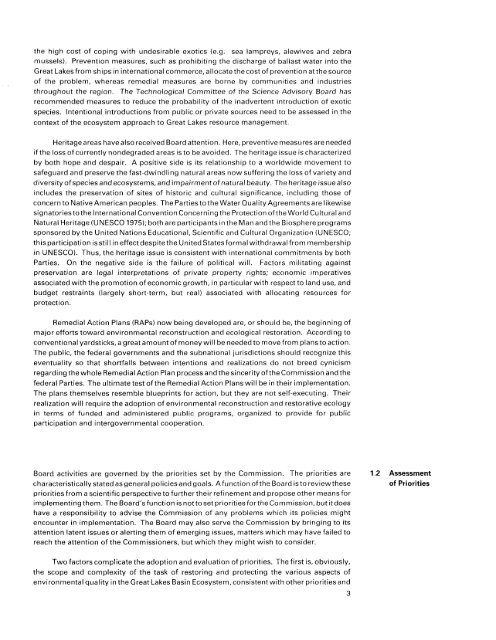International Joint Commission
International Joint Commission
International Joint Commission
Create successful ePaper yourself
Turn your PDF publications into a flip-book with our unique Google optimized e-Paper software.
the high cost of coping with undesirable exotics (e.g. sea lampreys, alewives and zebra<br />
mussels). Prevention measures, such as prohibiting the discharge of ballast water into the<br />
Great Lakesfrom ships in international commerce, allocatethecost of prevention atthesource<br />
of the problem, whereas remedial measures are borne by communities and industries<br />
throughout the region. The Technological Committee of the Science Advisory Board has<br />
recommended measures to reduce the probability of the inadvertent introduction of exotic<br />
species. Intentional introductions from public or private sources need to be assessed in the<br />
context of the ecosystem approach to Great Lakes resource management.<br />
Heritage areas have also received Board attention. Here, preventive measures are needed<br />
if the loss of currently nondegraded areas is to be avoided. The heritage issue is characterized<br />
by both hope and despair. A positive side is its relationship to a worldwide movement to<br />
safeguard and preserve the fast-dwindling natural areas now suffering the loss of variety and<br />
diversity of species and ecosystems, and impairment of natural beauty. The heritage issuealso<br />
includes the preservation of sites of historic and cultural significance, including those of<br />
concern to Native American peoples. The Parties to the Water Quality Agreements are likewise<br />
signatoriesto the <strong>International</strong> Convention Concerning the Protection of the World Cultural and<br />
Natural Heritage (UNESCO 1975); both are participants in the Man and the Biosphere programs<br />
sponsored by the United Nations Educational, Scientific and Cultural Organization (UNESCO;<br />
this participation isstill in effect despitethe United Statesformal withdrawal from membership<br />
in UNESCO). Thus, the heritage issue is consistent with international commitments by both<br />
Parties. On the negative side is the failure of political will. Factors militating against<br />
preservation are legal interpretations of private property rights; economic imperatives<br />
associated with the promotion of economic growth, in particular with respect to land use, and<br />
budget restraints (largely short-term, but real) associated with allocating resources for<br />
protection.<br />
Remedial Action Plans (RAPS) now being developed are, or should be, the beginning of<br />
major efforts toward environmental reconstruction and ecological restoration. According to<br />
conventional yardsticks, a great amount of money will be needed to move from plans to action.<br />
The public, the federal governments and the subnatiorial jurisdictions should recognize this<br />
eventuality so that shortfalls between intentions and realizations do not breed cynicism<br />
regarding the whole Remedial Action Plan processand the sincerity of the<strong>Commission</strong> and the<br />
federal Parties. The ultimate test of the Remedial Action Plans will be in their implementation.<br />
The plans themselves resemble blueprints for action, but they are not self-executing. Their<br />
realization will require the adoption of environmental reconstruction and restorative ecology<br />
in terms of funded and administered public programs, organized to provide for public<br />
participation and intergovernmental cooperation.<br />
Board activities are governed by the priorities set by the <strong>Commission</strong>. The priorities are<br />
characteristically stated asgeneral policiesand goals. Afunction ofthe Board isto reviewthese<br />
priorities from a scientific perspective to further their refinement and propose other means for<br />
implementing them. The Board’sfunction is nottosetprioritiesforthe <strong>Commission</strong>, but itdoes<br />
have a responsibility to advise the <strong>Commission</strong> of any problems which its policies might<br />
encounter in implementation. The Board may also serve the <strong>Commission</strong> by bringing to its<br />
attention latent issues or alerting them of emerging issues, matters which may have failed to<br />
reach the attention of the <strong>Commission</strong>ers, but which they might wish to consider.<br />
1.2 Assessment<br />
of Priorities<br />
Two factors complicate the adoption and evaluation of priorities. The first is, obviously,<br />
the scope and complexity of the task of restoring and protecting the various aspects of<br />
environmental quality in the Great Lakes Basin Ecosystem, consistent with other priorities and<br />
3

















